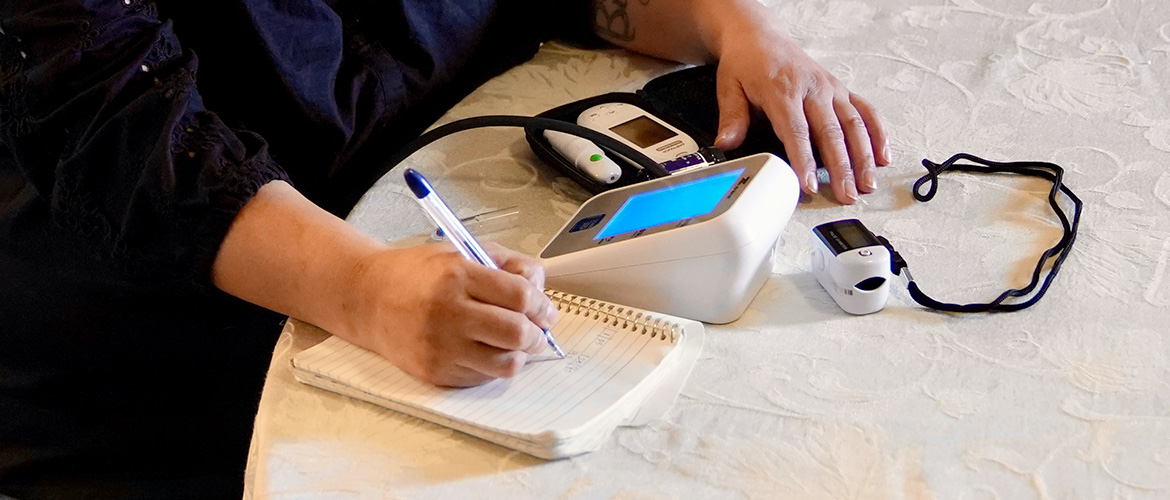Tennille Tsosie nearly died from diabetes last year.
Lacking insulin, she went into diabetic ketoacidosis. The life-threatening complication led to intense stomach pain that prompted her to call for an ambulance.
She was taken to a nearby Albuquerque emergency department — her sixth ED admission in 12 months. Doctors struggled to steady her blood pressure and oxygen level.
“They told me they thought I wasn’t going to make it,” says Tsosie, 46, who lives with her 72-year-old father in Albuquerque. “I thought, ‘who is going to take care of my dad?’ It really scared me.”
After three nights in intensive care, Tsosie, a Centennial Medicaid member through Health Care Service Corporation’s New Mexico health plan, was enrolled in the plan's Community Paramedicine program to help monitor her diabetes and help her get appropriate follow-up care after her hospital stay.
Launched in 2016, the program includes Albuquerque-area ambulance services, which visit Medicaid members with chronic conditions such as diabetes and congestive heart failure at their homes. Paramedics educate them about their conditions, medications and appropriate follow-up care and available resources.
“We form relationships that can be long-term and meaningful.”
Using real-time hospital data, the health plan identifies members who are discharged from the hospital and may benefit from a one-time visit or continued care monitoring in the Community Paramedicine program. It provides contracted ambulance providers with the names and contact information, and emergency medical workers such as paramedics then try to connect with the members within 72 hours after they were referred to the program.
“When we’re showing up on a 911 call it’s potentially the worst day of somebody’s life,” says John Mulhern, a 30-year community paramedic with Albuquerque Ambulance Service, a contracted provider with the program. “With community and mobile integrated health, we have the opportunity to practice preventive (care) before patients get to that level and hopefully keep them from getting sicker.”
Medical workers typically perform 10 home visits over a six-month span and may attend primary care or specialty appointments with members to help communicate care needs.
Tracking health from afar
HCSC also provided Tsosie with a Bluetooth-enabled pressure sensor cuff, pulse oximeter and weight scale to monitor her condition and help her avoid unnecessary emergency visits.
Remote monitoring allows real-time health information to be transmitted by wireless tools like those provided to Tsosie to help determine when members may need additional support via telehealth or in-person care.
More than half of members referred to the continued care program participated in the remote monitoring track between January 2019 and December 2021.
“Remote monitoring is an integral part of what we’re doing, and I feel it has the best capabilities to assist our members’ overall health and well-being,” says Julian Duran, clinical operations manager overseeing the Community Paramedicine program.
Additionally, participating members went to more provider appointments and established new relationships with primary care providers. Members are still visiting the ED, but fewer are receiving inappropriate care in these settings. As a result, total medical spending is shifting from acute hospital care to primary care services.
Reducing unnecessary emergency visits
The program’s one-time home visits — primarily for members with chest pain, respiratory infections and sepsis — also has performed well. Primary care appointments increased by 268 visits, leading to 45 fewer inpatient admissions during the study period.
“The consistency and continuity from beginning to end with these programs really goes a long way,” Duran says. “We’re seeing impactful change, and members feel comfortable working with our contracted paramedicine providers.”
Since beginning its Community Paramedicine program in Albuquerque, the New Mexico plan has established contracts with additional ambulance providers and expanded into regions such as Silver City. Duran says they hope to reach Las Cruces next year.
“We form relationships that can be long-term and meaningful,” says Mike Cavit, mobile integrated health supervisor at American Medical Response, which contracts with the program. “When I train staff, I tell them that this is your grandparent, and you want to advocate as if it is your grandparent. We attend doctor's appointments and discuss things as a medical professional with their doctors.”
There’s also renewed focus on streamlining care for members with social roadblocks to better health. In October, HCSC's plan began reaching out to members with social determinant of health needs through the paramedicine program, allowing team members to track progress. The program hired a community health worker to work with paramedics to evaluate how the interventions were working.
Since that change, the plan has reached 45 of the nearly 100 members who’ve participated in the paramedicine program, helping secure supplemental benefits, clothing and housing needs, and other non-medical health needs.
Compassion is key
For six months, paramedics checked in on Tsosie at her home to help see that she maintained her health and assessed whether she needed any non-medical assistance like food or transportation.
Tsosie took her prescribed medications, improved her blood sugar levels and completed the program in January. “My primary care provider and endocrinologist couldn’t believe how much I improved,” she remembers.
She struggles to keep her blood sugar levels on target but continues to track her diabetes in a personal logbook, and she’s thankful for the personal care provided in the program.
“During my paramedic’s last visit we sat and talked,” Tsosie says. “I hugged him, and I said ‘thank you, this really helped. You have no idea.’”

